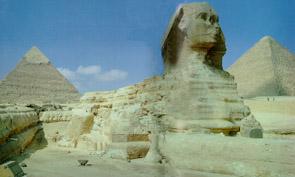|
Of
these two temples the southerly one was excavated by Egyptologists
before the one in front of the Sphinx and so was regarded
for a time as the temple of the Sphinx - the discovery of
the other one, long buried under the ever-drifting sands,
established that the Sphinx's own temple was this one straight
in front of the eastward-facing monument. The two temples
are similar in size and both face east in a north-south alignment;
each has a pair of north and south entrances in their eastern
facades. They are both built with core blocks quarried on
site, around the body of the Sphinx: some of these core blocks
of the Sphinx temple are three times larger than the core
blocks of the Great Pyramid. Both temples were faced, inside
and out, with finely dressed granite from Aswan in the far
south of Egypt, and floored with alabaster.
The Sphinx temple is very ruined now, with little of its granite
facing left and little of its alabaster floor. Any inscriptions
it may once have carried, which might have told us much about
its purpose, are long gone. Only the eroded limestone core
of the structure remains, in part: enough to show that this
temple once boasted a central court, about 46 m by 23 m, open
to the sky and affording a good view of the Sphinx, and there
was an interior colonnade of rectangular pillars. Large recesses
in the inside eastern and western walls suggest the original
presence of cult statues, very possibly to do with the rising
and setting sun, but there is no trace of decorative detail.
There was no immediate access to the Sphinx from inside the
temple, whose west wall up to the height of 2.5 m was cut
into the living rock, and thereafter topped with limestone
blocks. It was necessary to go by passages to the north and
south of the temple to reach the Sphinx. There is evidence
that this temple of the Sphinx was never finished.
The interior of the other temple, to the south of the Sphinx
temple, is quite different in layout, though the same granite
casing of the limestone core blocks, rectangular style of
pillar, presence of statue niches, overall size and method
of construction mark both buildings as contemporary Old Kingdom
temples.
In the southerly temple, the remains of nine more or less
complete statues of a king named on them as Khafre were found.
Further fragments show that twenty-three statues of Khafre
once stood in this temple, which Egyptologists identify as
the valley temple of Khafre's pyramid complex: the temple
on the edge of the Giza escarpment to which his body was brought
by a canal from the river at the start of the process that
would end with his being sealed within his pyramid Up on the
plateau above. Even in this century, the river in flood has
occasionally come very close to the terrace of the temples
by the Sphinx - and the water-table is not far below ground.
|
 |
The valley temple of Khafre lies at the end of a limestone
causeway that leads up the slope to a further temple at the
foot of his pyramid. The Greek writer Herodotus, who never mentions
the Sphinx as a feature on his visit to the pyramids (perhaps
it was all but obscured by sand in the fifth century BC), thought
the causeway of the Great Pyramid was as wonderful in its way
as the pyramids themselves. To judge by the causeways of slightly
later pyramids, these long ramps were covered over, with slits
in the roof to let in light, and possibly their walls even in
the time of Khufu and Khafre carried sculpted and painted scenes
on them, in contrast to the lack of decoration in the Giza pyramids
themselves.

The
Great Sphinx in modern times.
|
The Khafre causeway was equipped with drainage channels which
are interesting because they indicate that rainwater run-off
was an essential provision of the pyramid complex. We are accustomed
to think of Egypt as a very dry place but even nowadays, rain
can sometimes cause considerable damage in a context where it
is not routinely expected. Evidently the monuments of the Giza
necropolis needed precautions against rain. On the north side
of the Khafre causeway, there is a ditch (2 m wide and 1.5 m
deep) that forms a demarcation line between the pyramid complexes
of Khufu and Khafre. This rock-cut ditch was large enough to
channel a great deal of rainwater when heavy rains occurred.
It is cut into by the corner of the Sphinx enclosure, and -
were it not blocked at this point with pieces of granite - would
allow water to pour in quantity into the basin out of which
the Sphinx body was carved. These circumstances strongly suggest
that the Sphinx enclosure and the Sphinx itself were created
after the demarcation of the complexes of Khufu and Khafre and
after the construction of Khafre's causeway.
There are some tombs cut into the south-facing edge of the
wider Sphinx enclosure to the north that belong to the same
Dynasty IV as Khufu and Khafre, showing that the enclosure was
not made after their time. Between them, the blocked ditch and
the tombs indicate a narrow hand of time in which the Sphinx
enclosure, and by strong implication the Sphinx itself, could
have been carved. It means that the Sphinx most likely dates
to a time no later than a couple of reigns after Khafre and
no earlier than his reign.
|